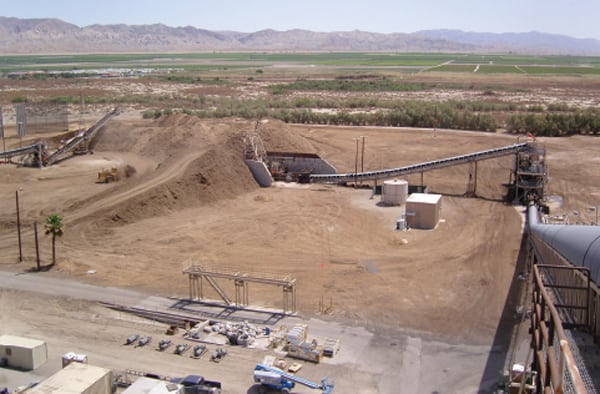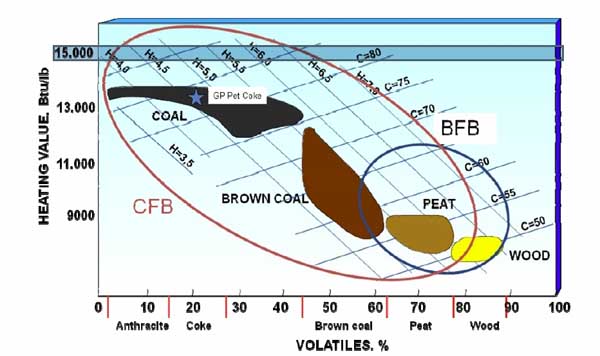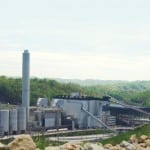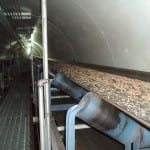Owner/operator: American Consumer Industries Inc.
The 47-MW Colmac Energy facility is the largest biomass-fueled power plant in California. Colmac operates with a capacity factor consistently in the 92% to 95% range and at a net plant heat rate comparable to waste coal facilities. Colmac Energy has demonstrated that biomass plants using urban wood wastes as fuel can generate significant environmental benefits, including reduced air pollutants from open-air burning and lowered demand for landfill space.
Through its impressive environmental accomplishments since beginning operations in 1992, the Colmac Energy Biomass-Fueled Power Plant has proven itself to be a good neighbor in the Coachella Valley. During its 18 years of operation, the plant has won over many individuals and organizations that initially feared the construction of a large power plant that burns wood in the “Palm Springs Valley,” which is a part of southern California known for its many resorts and recreational areas.
“Time has proven that the low emissions of the plant, and the collection of citrus and vineyard prunings and removals that would otherwise be open-burned, has essentially eliminated open-burning and the associated air pollution in the entire Coachella Valley,” said Graeme Donaldson, vice president of Colmac Energy Inc. “Further, the use of wood wastes as boiler fuel by Colmac contributes 9% to 10% to the required 50% diversion of landfill wastes that Riverside County is required by law to achieve. Our plant uses up to about 400,000 tons (not bone-dry tons) of biomass annually.”
The Colmac plant operates as a baseload generator of 47 MW net and delivers approximately 375,000 MWh per year to the California grid.
Focusing on the Facility’s Financials
Colmac has a 30-year power purchase agreement with Southern California Edison Co. (SCE) that terminates in February 2022. Under this contract, the plant receives both a payment for energy delivered and a capacity payment. A specified minimum amount of power must be delivered exceeding a minimum availability during specified times of the year in order to qualify for the capacity payment—in effect a continuous and continuing qualification requirement.
Currently, the energy payment is specified by a five-year agreement that provides a starting value of 6.15¢ per kWh and escalates at 1.0% per year. The plant is now in the fourth of the five years of this agreement. After the five-year agreement is concluded, payment for energy delivered by Colmac will revert to what is called in California the Market Index Factor (MIF), which is a gas-based price intended to represent the utility’s avoided cost. For some time, the MIF has been significantly lower than Colmac’s cost of generation.
Operations Overview
The plant operates two state-of-the-art circulating fluidized bed (CFB) boilers, generating approximately 464,000 pounds per hour of steam to drive a single ABB turbine generator train consisting of a high-pressure and low-pressure turbine configuration.
“The boilers are Combustion Engineering boilers, but have been extensively modified by Colmac Energy over the plant’s 18 years of operation for reliability and maintainability and bear little resemblance now to the original design,” Donaldson said.
He described a number of technical innovations that plant personnel have made at the facility. One of the more important ones is the basic configuration of using two boilers to drive a single turbine generator. Under this arrangement, one boiler can be taken offline for repairs or maintenance/modification and the plant can continue to operate at approximately 50% power. This minimizes loss of generation revenue as well as thermal cycling of the turbine and associated ancillary equipment.
Another innovation is the plant’s multiple-fuel capability. Donaldson explained that the plant is permitted to burn, in addition to biomass, tire-derived fuel (TDF, which is chipped tire rubber), and petroleum coke (petcoke), both high–energy density fuels. Although neither of these is normally burned in amounts greater than 1% or 2%, in the event of any problem with the wood fuel feed equipment, either can be introduced immediately through gravimetric feeders to the fuel feed. Together with the wood in the surge bins, the feed of petcoke or TDF, and the natural gas lances normally used only for start-up, generation can be maintained for extended periods to allow for correction of any wood feed problem. The plant staff can repair or replace any conveyor in the wood feed system in the time allowed by using the alternate fuels, without any loss of generation.
To control air emissions, Colmac combines the following strategies and technologies:
- Low-temperature combustion management of the CFB boilers to minimize emissions of volatile organic compounds and carbon monoxide.
- A selective noncatalytic reduction system (ammonia injection) for control of nitrogen oxides.
- Limestone injection for control of sulfur oxides.
- Teflon-lined fiberglass (Gore-Tex) bags in a baghouse on each boiler for control of particulate matter emissions.
- A Custom Instrumentation Services Corp. continuous emission monitoring system.
Handling Biomass as a Fuel Supply
“The Colmac plant is the only biomass plant in the greater Los Angeles and Inland Empire area of Southern California,” Donaldson said. “As such, it has access to the entire wood waste volume from over 10 million persons and thousands of businesses.”
The plant uses approximately 1,050 bone dry tons of biomass per day. It is permitted to burn, on an annual energy basis, up to 50% petcoke, 15% TDF, and 15% cardboard wastes. In addition, natural gas is permitted for start-up and flame stabilization purposes.
The plant’s biomass fuel breaks down into the following main categories:
- Clean urban wood wastes—including manufacturing wood scraps such as those that result from wood furniture manufacturing, broken pallets and wooden boxes, right-of-way tree trimmings, construction (but not demolition) wood scraps, and other wood residues—constitute 75% to 80% of the total fuel supply.
- Bark beetle–killed trees, removed from Southern California pine forests and then chipped, make up 5% to 10% of the plant’s fuel.
- Orchard and vineyard prunings account for the remaining 5% to 10% of the plant’s fuel.
Chipped wood wastes are delivered to the plant daily by 70 to 90 18-wheel tractor trailer trucks. The trucks are unloaded by one of the two elevating truck dumpers or are self-unloading walking-floor trucks. After the stack-out of the chips in the fuel pile by the rotating and luffing radial stacker, blending is done by large-wheeled loaders operating on the fuel pile, and reclaiming of the chips is handled by either the overpile or the underpile reclaimer. Chips are fed by the boiler feed conveyor to a transfer tower for optimum size reduction for combustion and then to final surge bins on each boiler (Figure 1).
 |
| 1. The fuel yard, as viewed from the boiler island. The wind screening, installed upwind of the fuel piles, very effectively minimizes dust generation. The rotating, luffing stacker is in the center of the photo. The reclaiming system, with both an overpile “backscratcher” reclaimer and an underpile system for backup, is at the right center. The reclaimer (beneath the fuel pile in the middle of the photo), when fully charged, provides about 24 hours of fuel feed. The reclaimer is charged every day before noon so that it is prepared for daily peak-hours generation. Courtesy: Colmac Energy Inc. |
From the surge bins, the chips are fed through a seal pot into the combustion zone of each of the two CFB boilers. Forced draft and induced draft fans, plus secondary overfire air, fluidize the boiler bed material to maintain the optimum bed suspension as the fuel is combusted.
The fuel has to be blended for consistency, which entails a three-step process:
- Horizontal layering in the fuel yard by the rotating stacker, thus minimizing concentration of any single truck’s load.
- Pushing the fuel to the reclaimer via the wheeled loaders, which is done by cuts through the layers.
- Reclaiming by a rotating overpile reclaimer, which is intended to provide the best possible consistency to the fuel mix sent to the boiler, particularly in terms of moisture content.
In addition, there are three large industrial magnets positioned above the conveyors at different locations in the fuel flow path to remove ferrous metals such as nails and staples.
The fuel yard is tested continually for elevated temperatures in order to minimize the danger of fuel pile fires. Hot fuel is immediately separated using the wheeled loaders and fed to the boiler.
Strong Teamwork Translates into Success
“The greatest asset of the facility is by far in all aspects its people,” Donaldson said. “By learning and applying leading-edge technologies, Colmac has consistently stayed ahead technologically of its comparable competition. Through constant staff vigilance, the Colmac plant has operated for over 18 years without a violation of any environmental conditions, a record believed to be unmatched by any solid fuel combustion plant.”
The Colmac plant is a stand-alone operation. The 54 full-time on-site staff handle all operations and maintenance, fuel procurement, administration, and finances. In addition, Donaldson explained that in the category designated as “dedicated indirect” employees, there are approximately 75 to 100 persons engaged full time in the fuel supply infrastructure.
“Scheduled major outages, conducted in the spring and fall of each year (before and after the summer ‘peak period’ of demand), are handled by a combination of Colmac staff and contract vendors,” Donaldson said. “This arrangement is called the ‘Colmac Family’ and ‘extended family’ as all support vendors have been involved with the project in excess of 10 years and look upon Colmac’s success as their success. There is no demarcation at the facility, as everyone works as one cohesive team, which shows in both the performance of the outages undertaken and completed and the plant’s elevated reliability that is the envy of the industry.”
— Angela Neville, JD, is senior editor of POWER.










